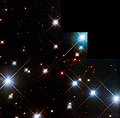File:Caldwell 76 (50291873217).jpg

Original file (1,514 × 1,492 pixels, file size: 754 KB, MIME type: image/jpeg)
| This is a file from the Wikimedia Commons. Information from its description page there is shown below. Commons is a freely licensed media file repository. You can help. |
Summary
| DescriptionCaldwell 76 (50291873217).jpg |
This image captures the shining stars in a portion of the open cluster Caldwell 76, also known as NGC 6231. It combines observations taken at ultraviolet, visible, and infrared wavelengths by Hubble’s Wide Field and Planetary Camera 2. This camera, before it was retired in 2009, was the highest resolution camera on any spacecraft capable of making observations in the far-ultraviolet range of the electromagnetic spectrum. Astronomers used the unique capabilities of the camera to survey Caldwell 76 and five other open clusters in the Milky Way with unprecedented clarity. By probing open clusters in the far-ultraviolet, astronomers were able to more efficiently find white dwarfs (the cores of stars that have shed their gaseous shell) that would be difficult to detect in the cluster using other methods. This was the first far-ultraviolet survey of open clusters in the Milky Way performed at such high resolution. Caldwell 76 is located in the constellation Scorpius, roughly 5,600 light-years from Earth. First discovered by the Italian astronomer Giovanni Battista Hodierna, it has an apparent magnitude of 2.6 and can be spotted with the naked eye when the skies are dark and clear. The cluster appears as a fuzzy patch of light to the unaided eye, but its individual stars can be resolved using a pair of binoculars. Caldwell 76 is easiest to observe during the winter in the Southern Hemisphere. It can be viewed from low latitudes of the Northern Hemisphere in the summer. The cluster is a popular target for southern observers because it is a part of the “False Comet” — a group of celestial objects that resembles a comet streaking across Scorpius. Caldwell 76 forms the head of the “comet,” while two other clusters and a cloud of gas and dust, called an emission nebula, form the tail. Credit: NASA, ESA, and J. Maiz Apellaniz (Centro de Astrobiologia [CSIC/INTA]); Processing: Gladys Kober (NASA/Catholic University of America) For Hubble's Caldwell catalog website and information on how to find these objects in the night sky, visit: <a href="https://www.nasa.gov/content/goddard/hubble-s-caldwell-catalog" rel="noreferrer nofollow">www.nasa.gov/content/goddard/hubble-s-caldwell-catalog</a> |
| Date | |
| Source | Caldwell 76 |
| Author | NASA Hubble Space Telescope |
Licensing
- You are free:
- to share – to copy, distribute and transmit the work
- to remix – to adapt the work
- Under the following conditions:
- attribution – You must give appropriate credit, provide a link to the license, and indicate if changes were made. You may do so in any reasonable manner, but not in any way that suggests the licensor endorses you or your use.
| This image was originally posted to Flickr by NASA Hubble at https://flickr.com/photos/144614754@N02/50291873217. It was reviewed on 16 December 2020 by FlickreviewR 2 and was confirmed to be licensed under the terms of the cc-by-2.0. |
16 December 2020
Captions
Items portrayed in this file
depicts
some value
16 November 2018
image/jpeg
f4f0178414c7899e9eb06006ff9517adb2a067ca
772,448 byte
1,492 pixel
1,514 pixel
File history
Click on a date/time to view the file as it appeared at that time.
| Date/Time | Thumbnail | Dimensions | User | Comment | |
|---|---|---|---|---|---|
| current | 17:43, 16 December 2020 |  | 1,514 × 1,492 (754 KB) | Szczureq | Transferred from Flickr via #flickr2commons |
File usage
Global file usage
The following other wikis use this file:
Metadata
This file contains additional information, probably added from the digital camera or scanner used to create or digitize it.
If the file has been modified from its original state, some details may not fully reflect the modified file.
| Orientation | Normal |
|---|---|
| Horizontal resolution | 72 dpi |
| Vertical resolution | 72 dpi |
| Software used | Adobe Photoshop 21.2 (Macintosh) |
| File change date and time | 14:45, 18 August 2020 |
| Y and C positioning | Centered |
| Exif version | 2.32 |
| Date and time of digitizing | 11:41, 16 November 2018 |
| Meaning of each component |
|
| Supported Flashpix version | 1 |
| Color space | sRGB |
| Bits per component |
|
| Compression scheme | Uncompressed |
| Height | 1,492 px |
| Width | 1,514 px |
| Pixel composition | RGB |
| Number of components | 3 |
| Type of media | Observation |
| Date metadata was last modified | 10:45, 18 August 2020 |
| Unique ID of original document | xmp.did:2a0e8a17-b599-429b-a862-eef4fc89f248 |
